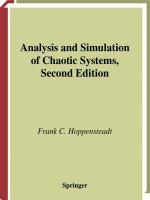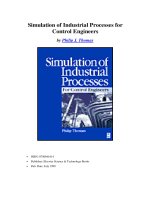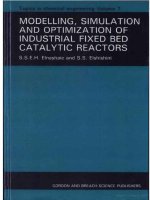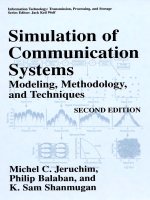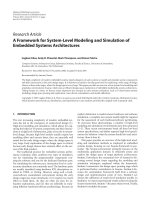Simulation of industrial systems (1)
Bạn đang xem bản rút gọn của tài liệu. Xem và tải ngay bản đầy đủ của tài liệu tại đây (8.91 MB, 538 trang )
SIMULATION OF
INDUSTRIAL SYSTEMS
CRC_AU6744_Fm.indd i
11/12/2007 9:08:59 PM
ENGINEERING AND MANAGEMENT INNOVATION SERIES
Hamid R. Parsaei and Ali K. Kamrani, Series Advisors
University of Houston, Houston, TX
Facility Logistics: Approaches and Solutions to Next Generation Challenges
Maher Lahmar
ISBN: 0-8493-8518-0
Simulation of Industrial Systems: Discrete Event Simulation Using Excel/VBA
David Elizandro and Hamdy Taha
ISBN: 1-4200-6744-3
Additional Titles in
RESOURCE MANAGEMENT SERIES
Rightsizing Inventory
by Joseph L. Aiello
ISBN: 0-8493-8515-6
Integral Logistics Management: Operations and
Supply Chain Management in Comprehensive
Value-Added Networks, Third Edition
by Paul Schönsleben
ISBN: 1-4200-5194-6
Supply Chain Cost Control Using
Activity-Based Management
Sameer Kumar and Matthew Zander
ISBN: 0-8493-8215-7
Financial Models and Tools for Managing
Lean Manufacturing
Sameer Kumar and David Meade
ISBN: 0-8493-9185-7
RFID in the Supply Chain
Judith M. Myerson
ISBN: 0-8493-3018-1
Handbook of Supply Chain Management,
Second Edition
by James B. Ayers
ISBN: 0-8493-3160-9
ERP: Tools, Techniques, and Applications
for Integrating the Supply Chain
by Carol A. Ptak with Eli Schragenheim
ISBN: 1-57444-358-5
Introduction to e-Supply Chain Management:
Engaging Technology to Build Market-Winning
Business Partnerships
by David C. Ross
ISBN: 1-57444-324-0
Supply Chain Networks and Business Process
Orientation
by Kevin P. McCormack and
William C. Johnson with William T. Walker
ISBN: 1-57444-327-5
Collaborative Manufacturing: Using Real-Time
Information to Support the Supply Chain
by Michael McClellan
ISBN: 1-57444-341-0
The Supply Chain Manager s Problem-Solver:
Maximizing the Value of Collaboration
and Technology
by Charles C. Poirier
ISBN: 1-57444-335-6
The Portal to Lean Production: Principles
& Practices for Doing More With Less
by John Nicholas and Avi Soni
ISBN: 0-8493-5031-X
Lean Performance ERP Project Management:
Implementing the Virtual Lean Enterprise,
Second Edition
by Brian J. Carroll
ISBN: 0-8493-0532-2
Supply Market Intelligence: A Managerial
Handbook for Building Sourcing Strategies
by Robert B. Handfield
ISBN: 0-8493-2789-X
Integrated Learning for ERP Success:
A Learning Requirements Planning Approach
by Karl M. Kapp, with William F. Latham and
Hester N. Ford-Latham
ISBN: 1-57444-296-1
The Small Manufacturer s Toolkit: A Guide to
Selecting the Techniques and Systems to Help
You Win
by Steve Novak
ISBN: 0-8493-2883-7
Basics of Supply Chain Management
by Lawrence D. Fredendall and Ed Hill
ISBN: 1-57444-120-5
Velocity Management in Logistics and Distribution:
Lessons from the Military to Secure the Speed
of Business
by Joseph L. Walden
ISBN: 0-8493-2859-4
Supply Chain for Liquids: Out of the Box
Approaches to Liquid Logistics
by Wally Klatch
ISBN: 0-8493-2853-5
Supply Chain Architecture: A Blueprint for Networking
the Flow of Material, Information, and Cash
by William T. Walker
ISBN: 1-57444-357-7
CRC_AU6744_Fm.indd ii
Lean Manufacturing: Tools, Techniques,
and How to Use Them
by William M. Feld
ISBN: 1-57444-297-X
Back to Basics: Your Guide to Manufacturing
Excellence
by Steven A. Melnyk and
R.T. Chris Christensen
ISBN: 1-57444-279-1
Enterprise Resource Planning and Beyond:
Integrating Your Entire Organization
by Gary A. Langenwalter
ISBN: 1-57444-260-0
ISBN: 0-8493-8515-6
11/12/2007 9:09:00 PM
SIMULATION OF
INDUSTRIAL SYSTEMS
Discrete Event Simulation Using Excel/VBA
David Elizandro • Hamdy Taha
New York
CRC_AU6744_Fm.indd iii
London
11/12/2007 9:09:00 PM
Microsoft, Windows, and Excel are registered trademarks of Microsoft Corporation in the United States and/
or other countries.
DEEDS is a copyright of David Elizandro.
CRC Press
Taylor & Francis Group
6000 Broken Sound Parkway NW, Suite 300
Boca Raton, FL 33487-2742
© 2007 by Taylor & Francis Group, LLC
CRC Press is an imprint of Taylor & Francis Group, an Informa business
No claim to original U.S. Government works
Version Date: 20140313
International Standard Book Number-13: 978-1-4200-6745-3 (eBook - PDF)
This book contains information obtained from authentic and highly regarded sources. Reasonable efforts
have been made to publish reliable data and information, but the author and publisher cannot assume
responsibility for the validity of all materials or the consequences of their use. The authors and publishers
have attempted to trace the copyright holders of all material reproduced in this publication and apologize to
copyright holders if permission to publish in this form has not been obtained. If any copyright material has
not been acknowledged please write and let us know so we may rectify in any future reprint.
Except as permitted under U.S. Copyright Law, no part of this book may be reprinted, reproduced, transmitted, or utilized in any form by any electronic, mechanical, or other means, now known or hereafter invented,
including photocopying, microfilming, and recording, or in any information storage or retrieval system,
without written permission from the publishers.
For permission to photocopy or use material electronically from this work, please access www.copyright.
com ( or contact the Copyright Clearance Center, Inc. (CCC), 222 Rosewood
Drive, Danvers, MA 01923, 978-750-8400. CCC is a not-for-profit organization that provides licenses and
registration for a variety of users. For organizations that have been granted a photocopy license by the CCC,
a separate system of payment has been arranged.
Trademark Notice: Product or corporate names may be trademarks or registered trademarks, and are used
only for identification and explanation without intent to infringe.
Visit the Taylor & Francis Web site at
and the CRC Press Web site at
Dedication
To Marcia and Karen
CRC_AU6744_Fm.indd v
11/12/2007 9:09:00 PM
CRC_AU6744_Fm.indd vi
11/12/2007 9:09:01 PM
Contents
Preface ........................................................................................................... xv
Acknowledgments ........................................................................................xxi
The Authors ............................................................................................... xxiii
PART I SIMULATION FUNDAMENTALS
1 Simulation Modeling ..............................................................................3
1.1 Why Simulate? .....................................................................................3
1.2 Types of Simulation .............................................................................5
1.3 The Simulation Clock ..........................................................................5
1.4 Randomness in Simulation ..................................................................7
1.5 Discrete Simulation Languages ............................................................7
1.6 Design Environment for Event-Driven Simulation ...............................8
1.7 The Two Sides of Simulation ................................................................9
1.8 Organization of the Book ...................................................................10
For Further Reading ...................................................................................11
Problems .....................................................................................................11
2 Probability and Statistics in Simulation ...............................................13
2.1 Role of Probability and Statistics in Simulation .................................13
2.2 Characterization of Common Distributions in Simulation ................14
2.2.1 Properties of Common Distributions .....................................14
2.2.1.1 Uniform Distribution ..............................................14
2.2.1.2 Negative Exponential Distribution ..........................15
2.2.1.3 Gamma (Erlang) Distribution .................................16
2.2.1.4 Normal Distribution ................................................17
2.2.1.5 Lognormal Distribution ...........................................17
2.2.1.6 Weibull Distribution ................................................18
2.2.1.7 Beta Distribution .....................................................19
2.2.1.8 Triangular Distribution ...........................................19
2.2.1.9 Poisson Distribution ................................................20
vii
CRC_AU6744_Fm.indd vii
11/12/2007 9:09:01 PM
viii
■
Contents
2.2.2 Identifying Distribution on the Basis of Historical Data ........21
2.2.2.1 Building Histograms................................................21
2.2.2.2 Goodness-of-Fit Tests ..............................................23
2.2.2.3 Maximum Likelihood Estimates of Distribution
Parameters ...............................................................26
2.3 Statistical Output Analysis .................................................................27
2.3.1 Confidence Intervals...............................................................27
2.3.1.1 Satisfying the Normality Assumption
in Simulation ...........................................................29
2.3.2 Hypothesis Testing .................................................................29
2.4 Summary ...........................................................................................32
References ...................................................................................................32
Problems .....................................................................................................33
3 Elements of Discrete Simulation ...........................................................37
3.1 Concept of Events in Simulation ........................................................37
3.2 Common Simulation Approaches.......................................................38
3.2.1 Event-Scheduling Approach ...................................................38
3.2.2 Activity-Scanning Approach ................................................. 44
3.2.3 Process-Simulation Approach ................................................ 46
3.3 Computations of Random Deviates ...................................................48
3.3.1 Inverse Method ......................................................................48
3.3.2 Convolution Method ..............................................................51
3.3.3 Acceptance–Rejection Method ...............................................53
3.3.4 Other Sampling Methods .......................................................55
3.3.5 Generation of (0, 1) Random Numbers ..................................56
3.4 Collecting Data in Simulation ...........................................................57
3.4.1 Types of Statistical Variables ..................................................57
3.4.2 Histograms .............................................................................59
3.4.3 Queue and Facility Statistics in Simulation ............................63
3.4.3.1 Queue Statistics .......................................................63
3.4.3.2 Facility Statistics ......................................................65
3.5 Summary ...........................................................................................68
References ...................................................................................................68
Problems .....................................................................................................68
4 Gathering Statistical Observations in Simulation ................................73
4.1 Introduction .......................................................................................73
4.2 Peculiarities of the Simulation Experiment.........................................73
4.2.1 Issue of Independence.............................................................74
4.2.2 Issue of Stationarity (Transient and
Steady-State Conditions).........................................................74
4.2.3 Issue of Normality ..................................................................76
CRC_AU6744_Fm.indd viii
11/12/2007 9:09:01 PM
Contents
■
ix
4.3 Peculiarities of the Simulation Experiment.........................................76
4.3.1 Normality and Independence ................................................ 77
4.3.2 Transient Conditions ..............................................................78
4.4 Gathering Simulation Observations .................................................. 80
4.4.1 Subinterval Method............................................................... 80
4.4.2 Replication Method................................................................83
4.4.3 Regenerative Method............................................................. 84
4.5 Variance Reduction ............................................................................86
4.6 Summary ...........................................................................................87
References ...................................................................................................88
Problems .....................................................................................................88
5 Overview of DEEDS .............................................................................89
5.1
5.2
5.3
5.4
Introduction .......................................................................................89
DEEDS Modeling Philosophy ...........................................................89
Basic Elements of DEEDS .................................................................91
Basic Features of DEEDS ...................................................................93
5.4.1 Network Representation .........................................................93
5.4.2 Time Management (Simulation Clock) ..................................93
5.4.3 DEEDS Class Definitions ......................................................94
5.4.4 User’s Files Management ........................................................94
5.4.5 Generation of Random Samples .............................................96
5.4.6 Statistical Observations Gathering .........................................96
5.4.7 Interactive Debugging and Trace............................................96
5.4.8 Computations of Mathematical
Expressions .............................................................................98
5.4.9 Initialization Capabilities .......................................................98
5.4.10 Output Capabilities ................................................................98
5.4.11 Model Documentation ...........................................................99
5.5 Develop and Execute a DEEDS Model ..............................................99
5.6 Summary ...........................................................................................99
6 DEEDS Network Representation ........................................................101
6.1 Components of the DEEDS Model..................................................101
6.1.1 DEEDS Nodes .....................................................................101
6.1.2 DEEDS Transactions ...........................................................102
6.1.3 DEEDS Lists ........................................................................102
6.1.4 DEEDS Classes and Procedures ...........................................103
6.1.5 DEEDS Simulation Program ...............................................104
6.2 Program Initial Conditions ..............................................................108
6.3 Summary ......................................................................................... 110
CRC_AU6744_Fm.indd ix
11/12/2007 9:09:01 PM
x
Contents
■
PART II EXCEL/VBA AND DESIGN ENVIRONMENT
FOR DISCRETE EVENT SIMULATION
7 VBA Programming .............................................................................113
7.1
7.2
7.3
7.4
7.5
7.6
7.7
7.8
Introduction .....................................................................................113
Names ..............................................................................................113
Data Types .......................................................................................113
Variable Definitions ......................................................................... 114
Constants ......................................................................................... 115
Expressions ....................................................................................... 116
Assignment Statements..................................................................... 117
Control Structures ........................................................................... 119
7.8.1 If .......................................................................................... 119
7.8.2 Case......................................................................................121
7.8.3 For........................................................................................123
7.8.4 Do ........................................................................................123
7.9 Procedures ........................................................................................124
7.9.1 Subs ......................................................................................125
7.9.2 Functions .............................................................................128
7.10 Arrays ...............................................................................................128
7.11 Summary .........................................................................................131
8 User Interface ......................................................................................133
8.1
8.2
8.3
8.4
8.5
8.6
8.7
8.8
8.9
8.10
8.11
8.12
Introduction .....................................................................................133
Overview of ProgramManager .........................................................133
Source Nodes ...................................................................................135
Queue Nodes ...................................................................................136
Facility Nodes ..................................................................................137
Initial Model ....................................................................................138
8.6.1 Build VBA Code ..................................................................139
8.6.2 Program Execution ...............................................................142
8.6.3 Viewing Options ..................................................................144
Delay Nodes.....................................................................................149
Statistical Variables ..........................................................................149
User-Defined Probability Functions ................................................. 153
User-Defined Tables ......................................................................... 155
Program Execution—Expanded .......................................................156
Summary ......................................................................................... 157
9 Modeling Procedures ..........................................................................159
9.1 Introduction ..................................................................................... 159
9.2 Visual Basic Procedures .................................................................... 159
9.3 Simulator Procedures .......................................................................160
CRC_AU6744_Fm.indd x
11/12/2007 9:09:01 PM
Contents
■
xi
9.4 DEEDS Classes ................................................................................162
9.4.1 Source ..................................................................................163
9.4.2 Queue...................................................................................165
9.4.3 Facility .................................................................................169
9.4.4 Delay .................................................................................... 176
9.4.5 Transaction ..........................................................................177
9.4.6 Statistic.................................................................................181
9.4.7 pdf........................................................................................183
9.4.8 Table ....................................................................................185
9.5 Distribution Functions .....................................................................186
9.6 Visual Basic Functions .....................................................................187
9.7 Excel WorksheetFunction ................................................................188
9.8 Summary .........................................................................................195
Problems ...................................................................................................195
10 Simulation Output ..............................................................................205
10.1
10.2
10.3
10.4
10.5
10.6
Introduction .....................................................................................205
Gathering Observations ...................................................................205
Simulation Messages ........................................................................207
Monitoring Simulation During Execution .......................................207
Forced Model Termination ............................................................. 208
Standard Output ............................................................................. 209
10.6.1 Source Sheet ........................................................................ 209
10.6.2 Queue Sheet ........................................................................ 209
10.6.3 Facility Sheet ........................................................................ 211
10.6.4 Delay Sheet ...........................................................................212
10.6.5 Statistics Sheet ......................................................................212
10.6.6 UserOutput Sheet .................................................................213
10.7 Model Verification ........................................................................... 214
10.7.1 User-Defined Simulator Messages ......................................... 214
10.7.2 Trace Report ......................................................................... 215
10.7.3 Collection Report ................................................................. 217
10.8 VBA Interactive Debugger ...............................................................218
10.9 Summary .........................................................................................223
11 Analysis of Simulation Results............................................................225
11.1 Introduction .....................................................................................225
11.2 Effect of Transient State ...................................................................227
11.3 Gathering Statistical Observations ...................................................232
11.4 Establishing Confidence Intervals ................................................... 234
11.5 Hypothesis Testing in Simulation Experiments ................................235
11.6 Summary .........................................................................................236
Reference ..................................................................................................236
CRC_AU6744_Fm.indd xi
11/12/2007 9:09:01 PM
xii
■
Contents
12 Modeling Special Effects .....................................................................237
12.1 Introduction.................................................................................237
12.2 A Multi-Server Facility to Represent Independent Facilities .........237
12.3 Facility Preemption Operation .....................................................240
12.4 Limit on Waiting Time in Queues .............................................. 242
12.5 Time-Dependent Intercreation Times at a Source ....................... 244
12.6 Network Logic Change Using Queue Nodes .............................. 246
12.7 Controlled Blockage of a Facility .................................................248
12.8 Assemble and Match Sets with Common Queues ........................250
12.9 Jackson Networks ........................................................................252
12.10 Sampling without Replacement....................................................254
Reference ..................................................................................................255
Problems ...................................................................................................255
13 Advanced Routing Techniques............................................................259
13.1
13.2
Introduction.................................................................................259
Routing Transactions ...................................................................259
13.2.1 Always Routing ............................................................. 260
13.2.2 Conditional Routing ..................................................... 260
13.2.3 Select Routing ................................................................261
13.2.3.1 Node Independent .........................................262
13.2.3.2 Current State of Node .................................. 264
13.2.3.3 “Recent History” of Node............................. 264
13.2.4 Probabilistic Routing......................................................265
13.2.5 Dependent Routing ....................................................... 266
13.2.6 Exclusive Routing...........................................................267
13.2.7 Last Choice ....................................................................267
13.3 Synchronized Queues...................................................................270
13.3.1 Match .............................................................................270
13.3.2 Assemble Transactions ...................................................272
13.4 Summary .....................................................................................274
Problems ..................................................................................................274
PART III APPLICATIONS
14 Simulation Project Management.........................................................281
14.1
14.2
14.3
14.4
14.5
CRC_AU6744_Fm.indd xii
Introduction.................................................................................281
System Specification.....................................................................281
Simulation Constants, Decision Variables, and Constraints.........283
Data Specifications...................................................................... 286
Project Management ................................................................... 288
14.5.1 Problem Definition .........................................................289
14.5.2 Preliminary Design ........................................................290
11/12/2007 9:09:01 PM
Contents
■
xiii
14.5.3 Validate Design ................................................................290
14.5.4 Model Development .........................................................290
14.5.5 Verify Model.....................................................................291
14.5.6 Design/Conduct Experiments ..........................................291
14.5.7 Summarize/Present Results ..............................................292
14.6 Summary .......................................................................................292
References .................................................................................................293
15 Facilities Layout Models .....................................................................295
15.1 Introduction ...................................................................................295
15.2 Line Balancing ...............................................................................296
15.3 Flexible Manufacturing Environment ........................................... 306
Reference .................................................................................................. 317
16 Materials-Handling Models ................................................................ 319
16.1 Introduction................................................................................... 319
16.2 Transporter Car ............................................................................. 319
16.3 Overhead Crane .............................................................................323
16.4 Carrousel Conveyor .......................................................................330
16.5 Belt Conveyor—Plywood Mill Operation .....................................334
References ................................................................................................ 342
17 Inventory Control Models.................................................................. 343
17.1 Introduction .................................................................................. 343
17.2 Discount Store Model ................................................................... 343
17.3 Periodic Review Model.................................................................. 348
17.4 Continuous Review Model .............................................................352
References .................................................................................................357
18 Scheduling Models ..............................................................................359
18.1 Introduction...................................................................................359
18.2 Job Shop Scheduling ......................................................................359
18.3 PERT Project Scheduling ..............................................................367
18.4 Daily Manpower Allocation...........................................................372
References .................................................................................................379
19 Maintenance and Reliability Models ..................................................381
19.1 Introduction ...................................................................................381
19.2 General Reliability Model ..............................................................381
19.3 Maintenance Scheduling ................................................................385
20 Quality Control Models ......................................................................397
20.1 Introduction ..................................................................................397
20.2 Costing Inspection Plans ...............................................................397
CRC_AU6744_Fm.indd xiii
11/12/2007 9:09:01 PM
xiv
■
Contents
20.3 Monitoring Control Charts ...........................................................403
Reference ..................................................................................................410
21 Supply Chain Models ..........................................................................411
21.1 Introduction ................................................................................... 411
21.2 Port Operation ............................................................................... 411
21.3 Automatic Warehouse Operation ...................................................421
21.4 Cross Dock Model ........................................................................ 430
References .................................................................................................439
Problems ...................................................................................................439
22 Advanced Analysis Techniques ...........................................................447
22.1 Introduction ..................................................................................447
22.2 Evaluation of Alternatives ..............................................................447
22.3 Design of Experiments ................................................................. 448
22.4 Simulation and Search Algorithms ................................................450
22.5 Cross Dock Problem ......................................................................452
22.6 Summary ...................................................................................... 464
References ................................................................................................ 466
Appendix A Initializing DEEDS ..............................................................467
Appendix B Classes and Procedures.........................................................479
Appendix C
Histograms Using Excel .......................................................489
Index ...........................................................................................................495
CRC_AU6744_Fm.indd xiv
11/12/2007 9:09:01 PM
Preface
Lean manufacturing describes the Toyota Production System. According to Taiichi
Ohno, the focus of Toyota was “the absolute elimination of waste.” There are variations on implementation of lean systems, but the essence is that a continuous
one-piece flow is ideal with emphasis on integrating systems of people, equipment,
materials, and facilities, to achieve improvements in quality, cost, on-time delivery,
and performance. Process improvements are typically described as a reduction in
cycle time or lead time; a reduction in the cost of space, inventory, and capital
equipment; an increase in capacity utilization; and the elimination of bottlenecks.
Production systems, based on the concept of lean manufacturing, are becoming
a paradigm across many industries. In a broader sense, operations management is
the practice of coordinating the physical work place with the people and work of
a particular organization to support organizational objectives. As such, operations
managers have responsibility for planning, operating, and maintaining complex
and diverse resources. Similar to manufacturing processes, improvements in these
production systems may also be described in terms of reduced cycle time, reduction in cost, increase in capacity utilization, and the elimination of bottlenecks. In
any production environment, discrete event simulation is a powerful tool for the
analysis, planning, design, and operation of those facilities.
This book is written for the novice who wants to learn the basics of discrete
simulation as well as for professionals who wish to use discrete event simulation
to model systems described above. The book assumes that the reader has a fundamental familiarity with modeling concepts and Excel; however, it does not assume
any prior programming experience. The book is organized into three parts. Part I
presents concepts of discrete simulation. Part II covers the Design Environment for
Event-Driven Simulation (DEEDS), and Part III presents a variety of applications
using DEEDS. The DEEDS environment is itself an Excel/VBA add-in.
Background
Basic approaches to discrete simulation have been process simulation languages
(e.g., GPSS) and event-scheduling type (e.g., SIMSCRIPT). The trade-offs are that
xv
CRC_AU6744_Fm.indd xv
11/12/2007 9:09:01 PM
xvi
■
Preface
event-scheduling languages offer more modeling flexibility and process-oriented
languages are more intuitive to the user.
Process-oriented languages are based on blocks (or nodes) that perform functions in serial fashion. For example, suppose that a transaction leaving a queue must
dispose of a previously acquired resource before it enters one of several available
facilities for processing. The leaving transaction must pass through a special block/
node to dispose of the resource and then through another to select the desired
facility.
In a process-oriented language, special blocks/nodes must be designed to
respond to distinct modeling needs. The result is that the language is not as userfriendly because of the high level of model abstractness and the large number of
blocks/nodes in the language. Also, the fact that transactions must pass through
these blocks/nodes serially does indeed reduce the language flexibility and may
create the need for external (FORTRAN, Visual Basic, or Java) program inserts. A
third disadvantage is that each special block/node is designed to respond to specific
modeling needs, an approach that inevitably leads to a degree of redundancy, and
hence inefficiency, in the language.
Objectives of the Book
With these considerations in mind, we embarked on the development of a new
discrete simulation environment. The design objectives are to
Ⅲ Achieve the modeling flexibility of an event-driven simulation language
Ⅲ Achieve the intuitive nature of a process-oriented language
Ⅲ Develop a user-friendly implementation environment
In essence, the goal was to design a development environment that is easy to use,
yet flexible enough to model complex production systems.
Approach
Using pioneering ideas of Q-GERT’s network simulation (nodes connected by
branches), Taha developed the simulation language SIMNET. The basis of SIMNET was that the majority of discrete simulations may be viewed in some form or
other as a complex combination of simple queuing systems. SIMNET has four basic
types of nodes: a source from which transactions arrive, a queue where transactions
may wait when necessary, a facility where service is performed, and a “Delay” node,
which is an infinite-capacity generalization of a facility node.
DEEDS implements the basic tenets of SIMNET in the Excel/VBA environment. Each node is designed to be self-contained, in the sense that user-developed
CRC_AU6744_Fm.indd xvi
11/12/2007 9:09:01 PM
Preface
■
xvii
event handlers written in Visual Basic for Applications (VBA) manage the transaction
before it enters and as it leaves the node. In essence, such a definition implements the
sequential nature of a process-oriented language, without the many blocks, and provides for the flexibility of event-driven simulation languages. This approach has proven
to be effective and convenient in handling very complex simulation models.
DEEDS is used by undergraduate industrial engineering students in the first
simulation course at Tennessee Technological University. These students have completed an information systems course based on Excel and VBA. It is gratifying to
report that these students were able to use DEEDS effectively to program fairly
complex models after only four weeks of instruction. Some of these models are
included in this book.
The students indicated the following advantages of DEEDS:
Ⅲ
Ⅲ
Ⅲ
Ⅲ
Excel facilitates model development and presentation of results.
With a VBA background, DEEDS is easy to learn.
A user interface facilitates model development and program management.
An interactive VBA debugger and “like English” trace report reduce the
effort to validate a model.
Ⅲ VBA class definitions facilitate managing the four network nodes.
Ⅲ Explicit simulator messages detail unusual events that occur during the
simulation.
Contents
The first part (Chapters 1 through 6) focuses on the fundamentals of simulation,
and the second part (Chapters 7 through 13) covers DEEDS. Chapters 14 through
22, the third part, present examples of production systems models and techniques
for using DEEDS to improve decision-making.
In Part I, the subject of simulation is treated in a generic sense to provide the
reader with an understanding of the capabilities and limitations of this important
tool. Chapter 1 provides an overview of simulation modeling with emphasis on the
statistical nature of simulation. Chapter 2 gives a summary of the role of statistics
in the simulation experiment. Chapter 3 is devoted to introducing the elements
of discrete simulation including types of simulation, methods for sampling from
distributions, and methods for collecting data in simulation runs. The material
in Chapter 4 deals with the statistical peculiarities of the simulation experiment
and ways to circumvent the difficulties arising from these peculiarities. Chapter
5 begins with an overview of the DEEDS environment. Chapter 6 introduces the
network representation and VBA classes to represent sources, queues, facilities, and
delays in DEEDS.
Although the material in Part I treats simulation in a general sense, it ties to
DEEDS by introducing and defining the terminology and the concepts used in the
CRC_AU6744_Fm.indd xvii
11/12/2007 9:09:01 PM
xviii
■
Preface
development of the language. The reader is encouraged to review at least Chapters
3 through 6 before beginning Part II.
In Part II, Chapter 7 provides an overview of the VBA essentials needed for
programming in the DEEDS environment. Chapter 8 presents features of the
ProgramManager, the user interface for program management. Also in Chapter 8 is
a description of the EventsManager module where the simulation program resides
and how to develop and execute a program. Chapter 9 presents details of developing
simulation programs in DEEDS. Included in Chapter 9 are Simulator procedures
and methods for DEEDS classes. In Chapter 10 are the output features of DEEDS
and model validation tools such as simulation reports and the VBA Interactive
Debugger. Chapter 11 presents details on how to conduct simulation experiments
in DEEDS. Chapter 12 presents a variety of programs that demonstrate the flexibility of DEEDS. In Chapter 13 are advanced features of DEEDS that assist the
modeler with complex transaction routing schemes.
In Part III, Chapter 14 presents concepts on the design and development of
large and complex simulation models. Also presented in Chapter 14 is an overview
of management issues related to simulation projects. In Chapters 15 through 21,
DEEDS simulation programs are designed and developed for a spectrum of traditional application areas that include facilities layout, materials handling, inventory
control, scheduling, maintenance, quality control, and supply chain logistics. For
the practitioner, models have been organized into chapters to address common
operations management topics. However, several models could easily fit into two
or more chapters.
All of the models were developed by senior students in an advanced simulation
course at Tennessee Tech University. Their models have been edited to emphasize certain DEEDS features. Solutions may be regarded as examples of how these
problems may be modeled in DEEDS. To conserve space, only selected output
results based on a single run for each problem are presented. Most of these problems
have been widely circulated in the literature as the basis for comparing simulation
languages.
In Chapter 22, the capstone chapter, the research features of DEEDS are demonstrated. In contrast to the traditional “what if” approach to simulation, design
of experiments and genetic algorithms techniques are integrated into the DEEDS
environment to produce a powerful tool that can be used for “optimizing” problems described in Chapters 15 through 21.
Use of This Book
The flexibility of DEEDS makes it a great tool for students or novice to learn concepts of discrete simulation. Therefore, it can be the basis for an undergraduate
course in introduction to simulation. By extending the depth of coverage, it can
be the basis for a graduate simulation course. It can also be a reference book for
CRC_AU6744_Fm.indd xviii
11/12/2007 9:09:02 PM
Preface
■
xix
practitioners engaged in simulation projects. It may also be used as a research tool
by faculty and graduate students who are interested in “optimizing” production
systems.
For projects that require animation, DEEDS can be used for rapid prototyping of the model so that simulation experiments can begin before the animation is
complete. For complex models, many of the VBA program segments from DEEDS
can also be used in the animation software and the DEEDS program can be used
as model documentation.
CRC_AU6744_Fm.indd xix
11/12/2007 9:09:02 PM
CRC_AU6744_Fm.indd xx
11/12/2007 9:09:02 PM
Acknowledgments
Recent simulation classes at Tennessee Tech University demonstrated that DEEDS
is a viable tool for teaching concepts of discrete event simulation. Neither this book
nor the DEEDS software would have been brought to fruition without the efforts
of Clinton Thomas, Julie Braden, Chad Watson, Jacob Manahan, Chris Potts, and
Chad Bournes. Each of these students made unique contributions to the design
of DEEDS and demonstrated that DEEDS is a viable tool for modeling complex
systems. Marcia Elizandro was very kind to contribute many hours by proofreading
early versions of the manuscript. Diane Knight was most helpful with editing the
final version. Randy Smith, at Microsoft, provided valuable advice on VB programming in Visual Studio. Finally, a very special thanks to Brandon Malone, a master’s
degree candidate in computer science at Tennessee Tech University who did a great
job helping to move the simulator from VBA to VB.net.
xxi
CRC_AU6744_Fm.indd xxi
11/12/2007 9:09:02 PM
CRC_AU6744_Fm.indd xxii
11/12/2007 9:09:02 PM
The Authors
David W. Elizandro is a professor of industrial engineering at Tennessee Tech University
where he teaches operations research and simulation. He earned a BS in chemical engineering, MBA, and PhD in industrial engineering.
Professor Elizandro has served in administrative
and leadership roles in science and engineering
education.
Professor Elizandro has written publications
and made presentations in areas such as expert
systems, data communications, distributed
simulation, adaptive control systems, digital
signal processing, and integrating technology
into engineering education. He has also been an
industry consultant on projects that include developing computer models to assess
manpower production requirements and resource utilization; evaluation of an overnight freight delivery network; performance of digital signal processing boards; and
response time for a flight controller communications system.
Professor Elizandro received the Distinguished Faculty Award, Texas A&M,
Commerce, served on the National Highway Safety Advisory Commission, and is
a member of Tau Beta Pi, Alpha Pi Mu, and Upsilon Pi Epsilon.
xxiii
CRC_AU6744_Fm.indd xxiii
11/12/2007 9:09:02 PM
xxiv
■
The Authors
Hamdy A. Taha is a university professor
emeritus of industrial engineering with the
University of Arkansas, where he taught and
conducted research in operations research
and simulation. He is the author of four other
books on integer programming and simulation,
and his works have been translated into Chinese, Korean, Spanish, Japanese, Malay, Russian, Turkish, and Indonesian. He is also the
author of several book chapters, and his technical articles have appeared in the European Journal of Operations Research, IEEE Transactions on
Reliability, IIE Transactions, Interfaces, Management Science, Naval Research Logistics Quarterly,
Operations Research, and Simulation.
Professor Taha was the recipient of the
Alumni Award for excellence in research and
the universitywide Nadine Baum Award for excellence in teaching, both from the
University of Arkansas, and numerous other research and teaching awards from
the College of Engineering, University of Arkansas. He was also named a Senior
Fulbright Scholar to Carlos III University, Madrid, Spain. He is fluent in three
languages and has held teaching and consulting positions in Europe, Mexico, and
the Middle East.
CRC_AU6744_Fm.indd xxiv
11/12/2007 9:09:02 PM


